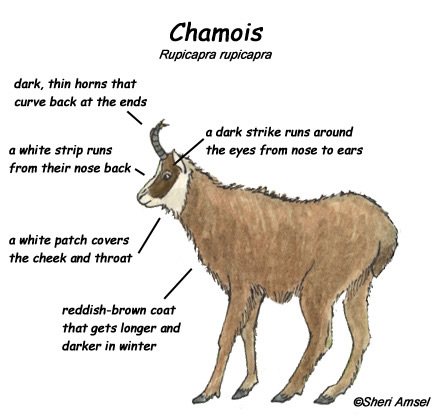

They are found in the Alps of Europe and Asia.
They live in high mountain grassy areas.
They can reach 4-feet long (130 cm) and weigh up to 140 pounds (62 kg). They have a reddish-brown coat that gets longer and darker in winter. Their faces are distinct with a white strip that runs from their nose back and a white patch that covers their cheeks and throat. A dark strike runs around the eyes from nose to ears. Both males and females have dark, thin horns that curve back at the ends.
They live high in the mountain in summer, staying in grassy areas at about 6,000 feet. In the winter they come down lower, even into forested areas, using steep cliffs to escape predators. They are amazing climbers, able to leap across 20-foot spans (6m). They can run 30mph (50kmh). Males usually live alone, while females live in flocks with young.
They eat grass mostly but will take leaves, buds and mushrooms.
They are hunted by lynx, wolves, and bears. Young are killed by foxes and large birds of prey.
Males compete for females in the fall “rut.” Females are pregnant for 5.5 months (gestation) and have 1-2 young in late spring. Babies can climb to safety with their mothers very soon after birth.
They can live more than 20 years in the wild. They are listed as Lower Risk - conservation dependent in much of their European range, but endangered in some mountainous regions where they are heavily hunted for food and there is habitat loss.
Kingdom: Animalia
Phylum: Chordata
Subphylum: Vertebrata
Class: Mammalia
Order: Artiodactyla
Family: Bovidae
Subfamily: Caprinae
Genus: Rupicapra
Species: Rupicapra rupicapra
When you research information you must cite the reference. Citing for websites is different from citing from books, magazines and periodicals. The style of citing shown here is from the MLA Style Citations (Modern Language Association).
When citing a WEBSITE the general format is as follows.
Author Last Name, First Name(s). "Title: Subtitle of Part of Web Page, if appropriate." Title: Subtitle: Section of Page if appropriate. Sponsoring/Publishing Agency, If Given. Additional significant descriptive information. Date of Electronic Publication or other Date, such as Last Updated. Day Month Year of access < URL >.
Amsel, Sheri. "Chamois Antelope" Exploring Nature Educational Resource ©2005-2024. December 13, 2024
< http://www.exploringnature.org/db/view/Chamois-Antelope >

